Many churches, cathedrals, and synagogues, built since the mid-1950s, used a modern form of faceted stained glass called Dalle de Verre to decorate their windows. But what is Dalle de Verre, how is it made, and what are its advantages compared to traditional leaded glass?
Dalle de Verre (from the French “slab of glass”) is a technique created by the French glass artist, Jean Gaudin in Paris in the 1930s. It is made from thick slabs of colored glass cut into shapes, faceted, arranged into patterns, and fixed in position with epoxy cement
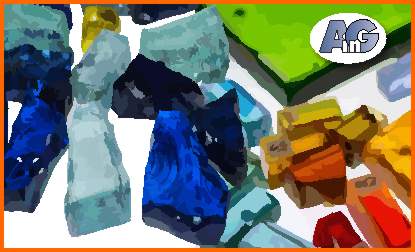
History of Dalle de Verre
The development of Dalle de Verre in the 1950’s coincided with the emergence of modernism in ecclesiastic art. After the destruction of buildings brought about by WWII, many artists took the opportunity, provided by damaged church windows to create a new, vibrant and optimistic form of glass art. Dalle de Verre with its coarse textures favored a mosaic style which, in turn, was appropriate for abstract rather than figurative designs.

Evolution of ecclesiastical art glass from Medieval (A), Neo-gothic (B), Impressionist (C), to abstract Dalle de Verre (D).
Evolution of production
Early Dalle de Verre panels were made with a matrix of concrete that was later discovered to expand at a different rate than glass causing cracking and structural failure. Since the mid-50s, a two-part epoxy resin that has similar thermal properties to glass has been used successfully. (We use a proprietary resin made by the Key Resin Company in Batavia, Ohio).
This technical improvement has made Dalle de Verre stronger but, contrary to common belief, it can still be broken by determined vandals.

Dalle de Verre panel from St. Francis de Sales Catholic Church in Tucson – this damage was repaired on-site by Artistry in Glass. Learn all about how to repair Dalles de Verre windows in this post.
Cautious custodians of churches and synagogues should take measures to install protective glazing in this unfortunate era of sacrilegious behavior. Study this video for details on how to preserve stained glass:
How are Dalle de Verre windows made?
The raw materials of Dalle de Verre are thick slabs of colored glass and a special, two-part epoxy resin.

The glass artist designs the panels in the usual way making a life-size pattern (cartoon) showing the positions of the pieces of colored glass. The glass is then shaped first by sawing with a glass saw and then by chiseling to fit exactly.
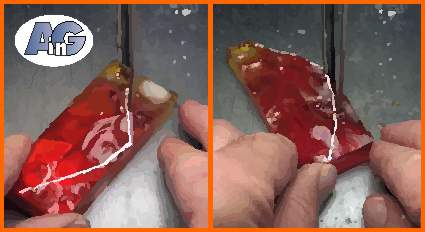
The edges of the pieces are faceted to produce conchoidal fractures which enhance the internal reflection and make the glass sparkle. Faceting is done with a carbide chisel, more simply with a special hammer. The process is similar to flint-knapping used by neolithic men to make sharp stone tools.
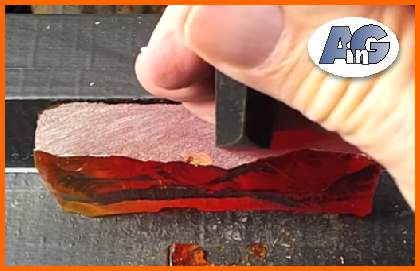
The individual pieces are laid out in a pattern by the glass artist inside a wooden form. The base of the form is painted with latex or covered in grease-proof paper to allow for the release of the epoxy. The spaces are then filled with special 2-part epoxy squeezed in from a dispenser like a piping bag used for icing a cake.
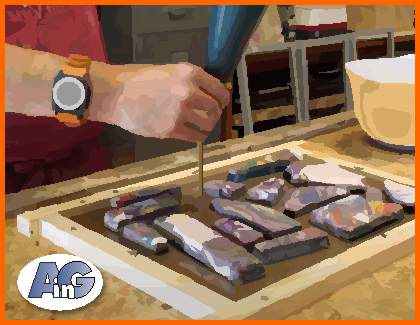
The epoxy is left to cure for up to a week to fully set up. Then the slab is released from the mold and cleaned ready for installation.
As an Amazon Associate, I earn from qualifying purchases
Differences between Dalle de Verre & leaded glass
Stained glass, more accurately called leaded glass, is made by joining pieces of thin (1/8″ thick) with a framework of lead came (sometimes zinc, brass, or copper).
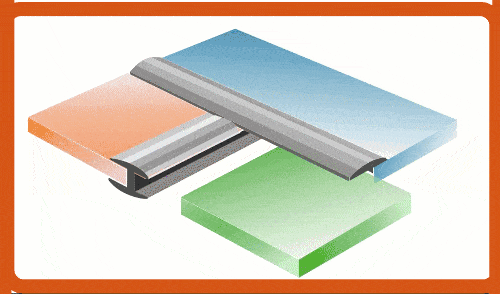
Traditional stained glass is very fragile and easily broken and so is usually protected from the weather and vandals by protective glass, plexiglass, or polycarbonate (Lexan).
In contrast, Dalle de Verre is considered to be much stronger and vandal-resistant. However, sad to say, even these strong panels can be busted by determined vandals.
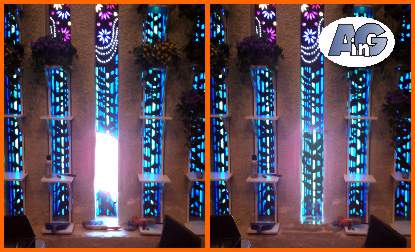
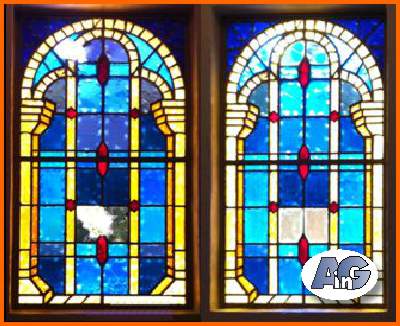
Restoration of Dalle de Verre
Artistry in Glass has restored numerous Dalle de Verre windows in the Tucson area. Follow this link for a list of churches & religious organizations that we have worked with.


Money-saving tip! Glass and mirror are essentially the same quality whichever shop you purchase them from. So save money by using these glass-buying tips from the experts at Artistry in Glass.
Commissioning a Dalle de Verre window
If you would like the vibrant beauty of Dalle de Verre for your place of worship, home, or even garden – use the same procedure as that explained in this post on commissioning stained glass.
The essential steps are:
- Establish a budget
- Choose a glass studio
- Consult with the glass artist
- Decide on your design
- Decide on your colors
- Approve the finished panel
- Approve the installation
To establish your budget – study the pricing calculators below
Price calculators for Dalle de Verre
The cost of a Dalle de Verre panel depends mainly on the complexity of the design:
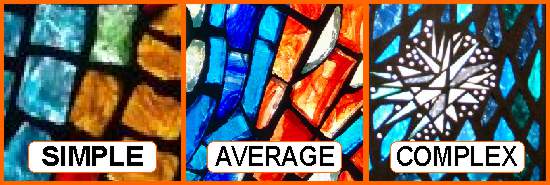
Beware of the weight – Dalle de Verre is very heavy!
In the price calculators below, take careful note of the weight of the panel. For ease of transport and installation, most Dalle de Verre experts make their panels 36″ square or less to keep the weight down to a manageable 100 lbs or less.
Remember that the prices above are just basic guides to the cost of manufacturing a Dalles de Verre panel. The total cost of the project will include additional design and installation charges.
Conclusion
Dalle de Verre is a strikingly beautiful way to beautify your church, temple, or public buildings. The art form is robust and resistant to weathering but still capable of being vandalized so church custodians should take protective measures. Call Artistry in Glass for detailed advice on the protection and restoration of Dalle de Verre windows.
All you need to know about art glass
Commissioning stained and etched glass
- Stained glass designs from Artistry in Glass
- How to commission a stained glass window – complete advice
- How to commission an etched glass window
- How to choose the best stained glass design
- Etched or stained glass – which is better for your home?
- How much does stained glass cost?
- How much does etched glass cost?
Technical information
- Is leaded glass dangerous? Learn the facts.
- How to replace broken patio table glass
- Plexiglass and glass – what are the pros and cons?
- What is plexiglass used for?
- What costs more – glass or plexiglass?
- Preservation of stained glass in churches & synagogues
- How does stained glass get colored? learn from an expert!
- Is your broken stained glass panel worth repairing?
- How to protect stained glass in religious buildings
- How to care for and clean stained glass
- How to repair cracked stained glass
- What is Dalle de Verre?
- How to repair Dalle de Verre
- What to do about bowed & sagging stained glass
- How to care for a stained glass skylight
- Can my stained glass lampshade be repaired?
- What is the difference between sandblasting & etching?
- Obscure and frosted glass – all you need to know!
- How to save money when buying glass
- Glossary of important terms used in decorative glass
- 14 Ways to sell stained glass
- What is imitation or faux stained glass?
Guides to stained glass design
- Guide for designing abstract stained glass
- Why choose abstract contemporary stained glass
- How to design a Frank Lloyd Wright-style window
- Designing a WWII-era stained glass Waco glider
- Stained glass and Black Lives Matter
- How Is stained glass used today?
Artistry in Glass was your source for antique repair in Tucson
Check out this amazing selection of informative articles:-
- Where can I get antiques repaired?
- Are broken antiques worth fixing?
- How to fix a broken picture frame
- How to repair a broken china plate
- How to repair a broken china teapot
- How to fix a broken marble slab
- How to repair a broken china coffee mug
- How to repair a 2000-year-old sculpture
- All about repairing stained-glass lampshades
- How to care for your stained glass skylight
- How to repair Dalle de Verre
- Is stained glass worth repairing?
- To repair or toss out?
- Tucson crystal & china repair a division of Artistry in Glass
- What to do with broken antiques
- Is lead crystal dangerous?
- Repairing an antique Mexican statue
- Repairing religious statues
- The history of Swarovski crystal figurines
- How to find the value of a Swarovski Crystal figurine
- Have Swarovski crystal figurines lost value since 2009?
- How to collect Swarovski annual ornaments
- How to display Swarovski crystal figurines
- How to authenticate a Swarovski crystal figurine
- How to display Swarovski annual ornaments
- How to clean Swarovski crystal figurines
- How to repair a Swarovski crystal mouse
- How to repair a Swarovski annual ornament
- How to repair a Swarovski crystal train set
- Fixing broken wine glass stems
- How to clean cloudy glasses
- Why do wine glasses have stems?
- Swarovski Crystal Figurines
- How to repair a chip in a wine glass
- How to fix a scratched glass tabletop
- How to replace a broken patio tabletop
